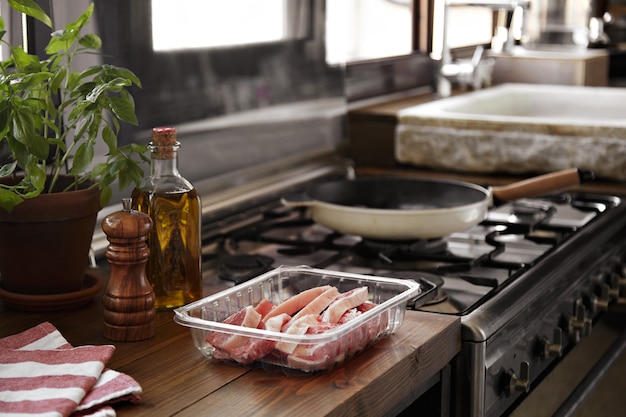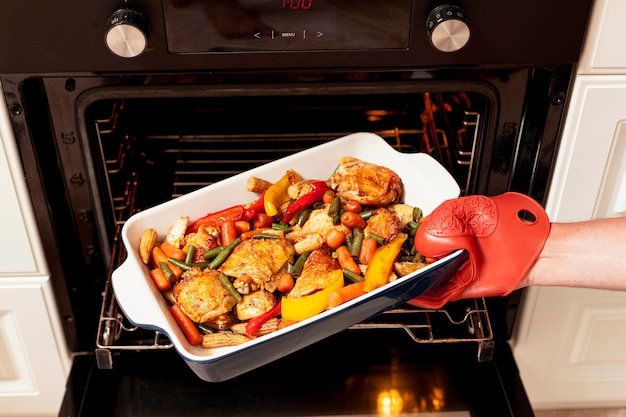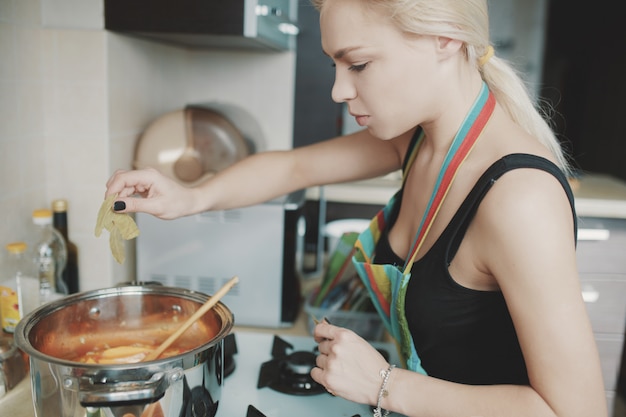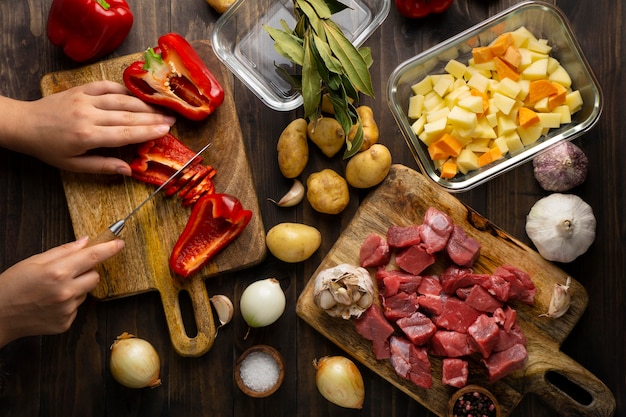Ah, pot roast. Just the name conjures up images of cozy evenings, hearty meals, and that amazing, melt-in-your-mouth tenderness that only a slow-cooked masterpiece can achieve. But let's be honest, sometimes the whole "pot roast" thing can feel a bit intimidating, especially when it comes to figuring out just how long to cook it. You don't want it to be tough as old boots, right?
This guide is for you – anyone who's ever wondered "how long do I cook this thing?" or "will it be done in time for dinner?". I'm going to break down everything you need to know about pot roast cooking times, covering everything from the cut of meat to the oven temperature, and even offering some handy tips to ensure your pot roast turns out perfectly every time. We're talking succulent, flavour-packed, and guaranteed to impress. Let's get cooking!
(Part 1) choosing the right cut - The Foundation of a Great Pot Roast

Finding the Perfect Cut
Now, before we dive into the oven, let's talk about choosing the right cut of meat. It's like choosing the right tool for the job. A big, sturdy hammer for nails, a delicate screwdriver for screws, and a pot roast cut for slow cooking! You want a cut that has a good amount of connective tissue – that's what breaks down during the long cooking process and gives you that beautiful, melt-in-your-mouth texture.
My top picks for pot roast are:
- chuck roast: A classic choice, the chuck roast is known for its rich flavour and good marbling. It's a tough cut, but that's why it's perfect for slow cooking. It's versatile, works well with a variety of flavour profiles, and holds its shape beautifully, making it ideal for carving.
- bottom round roast: A leaner option, the bottom round roast still benefits from a good slow cook. It's a good choice for carving thin slices, perfect for sandwiches or serving alongside vegetables. Be mindful that it's leaner, so keep an eye on moisture levels during cooking.
- Brisket: This cut is a bit more challenging, but the results are worth the effort. Brisket is full of flavour and gets incredibly tender when slow-cooked. It's a real commitment, requiring a longer cooking time, but the reward is a juicy, flavorful masterpiece that's perfect for pulled or sliced.
Decoding the Quality - What to Look For
It's always a good idea to give your roast a good look over before you buy it. You want it to have a good amount of marbling, which is the fat that runs through the meat. The more marbling, the more flavorful and tender your roast will be. Think of it like adding butter to a cake - it adds moisture and richness.
Also, look for a roast that's bright red in colour and has a good, firm texture. Avoid any roasts that have a dull colour, a slimy texture, or a strong odour. A fresh cut of meat should look inviting, not like it's been sitting around for too long.
(Part 2) Oven Temperatures and Cooking Times - The Science of Slow Cooking

Decoding the Basics - Temperature and Time
Okay, now we're getting into the heart of the matter. The oven temperature and cooking time are crucial for a perfect pot roast. You want to cook it at a low temperature for a long time to allow the connective tissue to break down and the flavours to meld together. It's like letting a good wine breathe - time and a gentle temperature bring out the best in it.
Here's a general guideline for oven temperatures and cooking times:
| Cut of Meat | Weight (lbs) | Oven Temperature (°F) | Approximate Cooking Time (hours) |
|---|---|---|---|
| Chuck Roast | 3-4 lbs | 325°F (160°C) | 3-4 hours |
| Bottom Round Roast | 3-4 lbs | 325°F (160°C) | 3-4 hours |
| Brisket | 4-5 lbs | 300°F (150°C) | 5-6 hours |
Beyond the Basics - The Variables
Remember, these are just general guidelines. The actual cooking time will depend on factors like the size and thickness of your roast, the type of oven you're using, and how much fat it has. A thicker roast will naturally need a little more time, just like a thicker steak.
It's always a good idea to use a meat thermometer to check the internal temperature of your roast. You want it to reach an internal temperature of 145°F (63°C) for medium-rare, 160°F (71°C) for medium, or 170°F (77°C) for well-done. This ensures the roast is cooked through and safe to eat, regardless of your desired level of doneness.
Mastering the Oven Techniques - A Choice of Methods
There are a few different methods you can use for roasting your pot roast, each with its own set of benefits. Here's a quick rundown:
- Roasting with vegetables: This is a classic method where you roast your pot roast with root vegetables like carrots, potatoes, and onions. The vegetables add moisture and flavour to the roast, and they're delicious to eat as well! It's a one-pot meal, making for less clean-up.
- Roasting in a dutch oven: This is a great method for creating a moist and flavorful pot roast. The Dutch oven traps the moisture and heat, ensuring the roast cooks evenly. It's also perfect for braising, which involves browning the roast and then simmering it in liquid, giving it an even deeper, richer flavour.
- Roasting in a slow cooker: If you're looking for an even more hands-off approach, a slow cooker is a great option. Simply place your roast and your chosen vegetables in the slow cooker, set it to low, and walk away. The slow cooker will do all the work for you, and you'll be rewarded with a tender and delicious pot roast. It's perfect for those busy weeknights when you need a meal that practically cooks itself.
(Part 3) Flavoring Your Pot Roast - The Art of Seasoning

Spicing Up the Flavor - A Symphony of Taste
Now, let's talk flavour! A pot roast is a blank canvas just waiting for your personal touch. I'm a firm believer in simple, classic seasonings that really let the natural flavour of the meat shine.
Here are my go-to seasonings for pot roast:
- Salt and pepper: These are the essentials, of course. I always use freshly ground black pepper for a bit of extra zing. Salt enhances the natural flavours of the meat, while pepper adds a bit of warmth and complexity.
- Garlic powder: A touch of garlic powder adds a lovely warmth and depth of flavour. It's a subtle yet essential ingredient that brings out the richness of the meat.
- Onion powder: Similar to garlic powder, onion powder brings a sweet and savory element. It adds another layer of depth and complexity to the flavour profile.
- Paprika: For a hint of smokiness and a beautiful colour. It adds a subtle sweetness and a touch of heat to the roast, making it more interesting.
- Dried herbs: Thyme, rosemary, and oregano are great additions to a pot roast. They add a touch of herbal complexity that complements the meat beautifully. Each herb adds its own unique flavour profile - thyme is earthy and slightly citrusy, rosemary is piney and aromatic, and oregano is slightly bitter and pungent.
The Power of a Rub - Boosting the Flavor Profile
For an extra layer of flavour, try making a simple spice rub. Simply combine your favourite seasonings and rub them all over the roast before cooking. This helps to lock in the flavour and create a delicious, crispy crust.
Here's a recipe for a basic pot roast rub:
- 1 tablespoon salt
- 1 tablespoon black pepper
- 1 teaspoon garlic powder
- 1 teaspoon onion powder
- 1 teaspoon paprika
- 1 teaspoon dried thyme
- 1 teaspoon dried rosemary
Just combine all the ingredients in a small bowl and rub it all over the roast. Make sure to get it into all the nooks and crannies to ensure even flavour distribution.
(Part 4) The Browning Stage - Unleashing the Flavor
Searing for Flavor - Building a Delicious Crust
Before you pop that pot roast in the oven, I strongly recommend browning it. This step gives the roast a beautiful, crispy crust and adds a wonderful depth of flavour. Think of it like searing a steak - it creates a flavorful barrier that seals in the juices.
To brown your pot roast, heat a large oven-safe skillet over medium-high heat. Add a tablespoon or two of oil to the skillet and let it heat up. You can use any oil you like, but I usually go with olive oil or vegetable oil. The key is to use a high heat so the roast browns quickly and develops that beautiful crust.
Once the oil is hot, add your roast to the skillet. Let it cook for about 5-7 minutes per side, or until it's nicely browned. Don't worry if it doesn't cook all the way through, we'll take care of that in the oven. Focus on getting that golden-brown colour and those delicious sear marks.
Enhancing the Flavor - Adding Vegetables
Once the roast is browned, you can add your chosen vegetables to the skillet. Let them cook for a few minutes until they're slightly softened. This helps to enhance their flavour and creates a beautiful base for your pot roast. The caramelized vegetables add another layer of sweetness and depth to the dish.
Deglazing - Extracting the Flavor
You can also deglaze the skillet after browning the roast. This involves adding a splash of liquid, like wine or broth, to the pan and scraping up all the delicious bits that have stuck to the bottom. It's a great way to add even more depth of flavour to your pot roast. The liquid reacts with the browned bits, creating a delicious sauce that can be used to baste the roast or serve alongside it.
(Part 5) The Oven Part of the Show - Slow and Steady Wins the Race
Roasting and Resting - Patience is Key
Now, it's time to transfer your pot roast to the oven. If you're using a skillet, you can simply transfer the whole thing to the oven. If you're using a Dutch oven or a roasting pan, make sure to cover it with a lid or some foil to help keep the moisture in. The goal is to create a moist environment where the roast can cook slowly and evenly.
Cook your pot roast for the recommended time, as mentioned earlier in the guide. It's important to let the roast rest for at least 15 minutes after cooking. This allows the juices to redistribute, resulting in a more tender and flavorful roast. This resting period is crucial for achieving that perfect level of tenderness and juiciness.
When you're ready to carve, slice the roast against the grain. This helps to break down the muscle fibers and makes for easier chewing. It also ensures that the roast is sliced beautifully and evenly, making it more appealing to serve.
(Part 6) pot roast variations - Beyond the Basics
The World is Your Oyster - Creative Twists on a Classic
Let's be honest, a classic pot roast is a great dish, but sometimes you just want to spice things up a bit! There are endless possibilities when it comes to adding your own unique twist.
Here are a few ideas to get you started:
- Italian Pot Roast: Use a blend of Italian herbs like basil, oregano, and thyme. Add a splash of red wine or red wine vinegar during the cooking process. Serve with roasted peppers and onions. It's a flavourful and aromatic dish that's perfect for a comforting Italian meal.
- Mexican Pot Roast: Use a blend of Mexican spices like cumin, chili powder, and oregano. Add a can of diced tomatoes and some Mexican-style beer. Serve with corn tortillas and your favorite toppings. It's a fiesta of flavour, with a touch of heat and sweetness that will tantalize your taste buds.
- Asian Pot Roast: Use a blend of Asian spices like ginger, garlic, soy sauce, and hoisin sauce. Add some diced mushrooms and green onions. Serve with rice and stir-fried vegetables. It's a fusion of flavours, combining the savory and sweet with a hint of umami.
Make it Your Own - Embrace the Experimentation
The beauty of pot roast is that you can really make it your own. Experiment with different spices, vegetables, and liquids. You can also add ingredients like potatoes, carrots, onions, or even dried fruit. Get creative and have fun with it. The possibilities are endless, and you'll discover your own signature pot roast recipe along the way.
(Part 7) Serving Your Pot Roast - A Feast Fit for a King
A Culinary Masterpiece - Time to Enjoy
Now, the moment of truth! After all that hard work, it's time to enjoy your masterpiece!
Here are a few ideas for serving your pot roast:
- Classic: Carve the roast and serve it with mashed potatoes, gravy, and your favourite vegetables. You can't go wrong with this classic combination. It's simple, comforting, and always satisfying.
- Elevated: Serve your pot roast over a bed of creamy polenta or risotto. Add a splash of red wine sauce or a sprinkle of fresh herbs for extra flavour. This elevates the dish to a whole new level of sophistication.
- comfort food: Make a hearty sandwich with your pot roast, Add some cheese, pickles, and onions. It's a perfect way to use up leftovers. This is a delicious and satisfying way to enjoy your pot roast, especially if you have leftovers.
Leftover Love - Making the Most of Your Creation
If you have any leftovers, you can use them in a variety of dishes. Try making a pot roast hash, a pot roast soup, or a pot roast salad. Leftovers are a gift, giving you another opportunity to enjoy your delicious pot roast.
(Part 8) FAQs - Answering Your Pot Roast Questions
Here are some answers to common questions about pot roast cooking:
1. What if my roast isn't fully cooked?
Don't panic! You can always cook it a little longer. Just check the internal temperature with a meat thermometer. Make sure to cook it to the desired internal temperature before serving.
2. What if my roast is too dry?
If your roast is a bit dry, you can try adding a little more liquid to the pan. You can also try covering the roast with foil for the last 30 minutes of cooking. This will help trap the moisture and create a more tender and juicy roast.
3. How do I make the best gravy?
The key to making delicious gravy is to deglaze the pan after cooking the roast. Add a splash of liquid, like wine or broth, to the pan and scrape up all the delicious bits that have stuck to the bottom. Bring the liquid to a simmer and whisk in some cornstarch or flour to thicken the gravy. The key is to create a smooth and flavorful sauce that complements the roast perfectly.
4. Can I freeze pot roast?
You can freeze pot roast for up to 3 months. Just make sure to wrap it tightly in plastic wrap and aluminum foil. To thaw, transfer the roast to the refrigerator for 24 hours. This is a great way to save time and have a delicious meal ready to go when you need it.
5. What are some tips for making a juicy pot roast?
Here are some tips for making a juicy pot roast:
- Use a roast with good marbling. This will add flavor and moisture to the roast.
- Sear the roast before cooking it in the oven. This will help to lock in the juices.
- Cook the roast at a low temperature. This will allow the connective tissue to break down and the meat to become tender.
- Use a meat thermometer to check the internal temperature. This will ensure that the roast is cooked to your desired level of doneness.
- Let the roast rest for at least 15 minutes after cooking. This will allow the juices to redistribute and make the roast even more tender.
Final Thoughts - Embrace the Pot Roast Journey
So there you have it – everything you need to know about cooking a pot roast to perfection. Remember, it's all about choosing the right cut, using the right oven temperature, and adding your own personal touch. Don't be afraid to experiment and have fun with it! Your taste buds will thank you for it. Embrace the journey, and you'll be rewarded with a culinary masterpiece that will become a family favourite.
Everyone is watching

Perfect Rice Every Time: The Ultimate Guide to Cooking Rice
Cooking TipsAs a self-proclaimed foodie, I've always been a bit obsessed with rice. It's the foundation of countless cuisi...

Ultimate Guide to Cooking the Perfect Thanksgiving Turkey
Cooking TipsThanksgiving. Just the word conjures up images of overflowing tables laden with delicious food, the scent of r...

The Ultimate Guide to Cooking Asparagus: Tips, Techniques, and Recipes
Cooking TipsAsparagus. The mere mention of this spring delicacy conjures up images of vibrant green spears, crisp and burs...

Can You Cook Spaghetti with Gasoline? (The Shocking Truth)
Cooking TipsWe've all seen those crazy internet trends. You know, the ones that make you wonder, "Did someone actually try...

Chorizo and Eggs Recipe: The Ultimate Guide
Cooking TipsRight, let’s talk about chorizo and eggs. You know, that classic Spanish dish that's always a winner. It's th...
